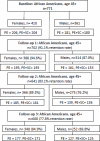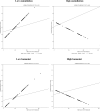Comparing the use of evidence and culture in targeted colorectal cancer communication for African Americans
- PMID: 20702056
- PMCID: PMC2988986
- DOI: 10.1016/j.pec.2010.07.019
Comparing the use of evidence and culture in targeted colorectal cancer communication for African Americans
Abstract
Objective: This study examined the effects (affective reactions, cognitive reactions and processing, perceived benefits and barriers and intent to screen) of targeted peripheral+evidential (PE) and peripheral+evidential+socio-cultural (PE+SC) colorectal cancer communications.
Methods: This study was a two-arm randomized control study of cancer communication effects on affective, cognitive processing, and behavioral outcomes over a 22-week intervention. There were 771 African American participants, 45-75 years, participating in the baseline survey related to CRC screening. Three follow-up interviews that assessed intervention effects on affective response to the publications, cognitive processing, and intent to obtain CRC screening were completed.
Results: There were no statistically significant differences between PE and PE+SC intervention groups for affect, cognitive processing or intent to screen. However, there were significant interactions effects on outcome variables.
Conclusions: The advantages and disadvantages of PE+SC targeted cancer communications and implications of sex differences are considered.
Practice implications: While there do not appear to be significant differences in behavioral outcomes when using PE and PE+SC strategies, there appear to be subtle differences in affective and cognitive processing outcomes related to medical suspicion and ethnic identity, particularly as it relates to gender.
Copyright © 2010 Elsevier Ireland Ltd. All rights reserved.
Figures
References
-
- American Cancer Society . Cancer Facts & Figures for African Americans 2009. American Cancer Society; Atlanta, GA: 2009.
-
- Centers for Disease Control and Prevention Comparing Colorectal Cancer by Race and Ethnicity. http://www.cdc.gov/CANCER/colorectal/statistics/race.htm, October 20, 2009.
-
- Horner MJ, Ries LAG, Krapcho M, Neyman N, Aminou R, Howlader N, Altekruse SF, Feuer EJ, Huang L, Mariotto A, Miller BA, Lewis DR, Eisner MP, Stinchcomb DG, Edwards BK, editors. SEER Cancer Statistics Review, 1975-2006. National Cancer Institute; Bethesda, MD: 2009. http://seer.cancer.gov/csr/1975_2006/, based on November 2008 SEER data submission, posted on the SEER web site.
-
- Byers T, Levin B, Rothenberger D, Dodd G, Smith R. American Cancer Society guidelines for screening and surveillance for early detection of colorectal polyps and cancer: Update 1997. American Cancer Society Detection and Treatment Advisory Group on Colorectal Cancer. CA - Cancer J Clin. 1997;47:154–60. - PubMed
-
- U. S. Department of Health and Human Services . Healthy People 2010 Objectives. US Government Printing Office; Washington, DC: 2000.
Publication types
MeSH terms
Grants and funding
LinkOut - more resources
Full Text Sources
Medical








